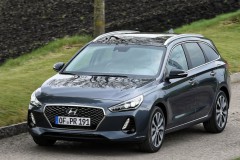Hyundai i30 2017 1.6 CRDi
Hyundai i30 2017 1.6 diesel description
Estate car / wagon Hyundai i30 2017 1.6 CRDi is being produced from 2017. It has four-cylinder diesel engine with displacement of 1.6 litres, which produces power of 136 horsepower on 4000 rpm and torque 300 Nm (Newton metres) on 1750 revolutions per minute.
This 4-cylinder 16-valve engine camshaft is driven by chain (What is an engine chain and belt? ). Engine has Common Rail fuel system and Garrett GTE1244VZM turbine. The engine meets the Euro 6 emissions standard. Approximate engine life expectancy (mileage until serious repairs are required) for this engine is between 220 000 and 370 000 kilometres. Remember that engine life depends on regular maintenance and the quality of the materials used (oils, fuels, etc.).
More engine specs
This Hyundai i30 1.6 engine oil type is 5W-30 and oil capacity is 4.4 litres.
Hyundai i30 2017 1.6 CRDi has front wheel drive (FWD) and automatic gearbox with 7 gears.
Hyundai i30 2017 1.6 CRDi accelerates to speed 100 kilometres per hour in 10.9 seconds. The maximum speed of this car is 198 km/h.
The fuel consumption of this version of Hyundai i30 2017 1.6 CRDi reported by owners in daily driving mode is 5.9 litres per 100km.
Hyundai i30 safety
During safety testing Hyundai i30 has obtained 5 stars from five, which means very high safety level.
Adults (driver and passenger) safety of Hyundai i30 is evaluated with very good rate 88 from 100, children safety: very good mark - 84 from 100, for pedestrian protection Hyundai i30 got 64 points from 100.
Hyundai i30 safety equipment has been rated as average - 68 percents from 100.

Hyundai i30 2017 1.6 CRDi technical data
| Model: | Hyundai i30 1.6 CRDi | ||
|---|---|---|---|
| Body style: | Estate car / wagon | ||
| Production period: | 2017. January | ||
| Engine: | 1582 cm3 Diesel, 4 cylinders | CO2 emissions: | no data |
| Power: | 136 HP ON 4000 RPM | Torque: | 300 NM ON 1750 RPM |
| Gearbox: | Automatic gearbox (7 gears) | Drive type: | Front wheel drive (FWD) |
| Top speed: | 198 km/h | Acceleration 0-100 km/h: | 10.9 seconds |
| Fuel consumption: | 5.9 l/100km (39.9 MPG) by user reviews from various sources | ||
| Fuel tank capacity: | 50 litres (13.2 gallons) | ||
| Car dimensions: | 4.59m (length) 1.80m (width) 1.47m (height) | ||
| Ground clearance: | 140 mm (approximate, with standard suspension, unladen vehicle) | ||
| Trunk capacity: | 602 litres | ||
| Trunk max capacity: | 1650 litres (with rear seats folded down) | ||
| Gross weight: | 1940 kg | ||
Hyundai i30 2017 1.6 CRDi engine D4FE
Engine reliability:
Overall, this engine can last around 220,000 to 370,000 km if properly maintained, using the correct quality oil and fuel, and carrying out regular checks and maintenance.The engine has hydraulic valve tappets (lifters), which provide quieter operation and do not require periodic adjustment, but are more complex in design and can cause serious engine damage in the event of failure.
| Engine displacement | 1598 cm3 |
|---|---|
| Number of cylinders | 4 |
| Bore (cylinder diameter) | 77 mm |
| Stroke length (piston move) | 85.8 mm |
| Compression ratio | 15.9 : 1 |
| Camshaft drive | Timing chain Chain motors are considered more reliable, chain replacement usually is required less often than a timing belt, but they are often louder and vibrate more. |
| Fuel system | Common Rail Common rail fuel injection provides more engine power, is quieter, more environmentally friendly and offers better fuel economy, but is more expensive to maintain and repair. |
| Hyundai i30 2017 1.6 CRDi oil type | 5W-30 |
| Oil capacity | 4.4 litres (4.7 quarts) |
| Power | 116 - 136 HP ON 4000 RPM |
| Torque | 280 - 320 NM ON 1750 RPM |
| Start of production (year) | 2017 |
| Duration of production | 8 years |
Often in the first years of production, engines tend to have various constructive problems, so it is recommended to choose a car with this engine from 2020 onwards. |
|
| Engine also used on | Kia Sportage Kia Ceed Hyundai Tucson Kia Optima and 2 other models |
Generally, the use of an engine in several models and its long production run is an indication of the quality of the engine and the success of its design. |
All Hyundai i30 estate car [2017 modifications
| Modification | Engine | Power | Consumption | Gearbox |
|---|---|---|---|---|
|
Hyundai i30 2017 Wagon 1.0
Jun 2017 — Most fuel efficient petrol version |
1.0 Petrol | 120 HP | 4.5 l/100km | Manual (6) |
| Hyundai i30 2017 1.4 | 1.4 Petrol | 100 HP | - | Manual (6) |
|
Hyundai i30 2017 Wagon 1.4
Jun 2017 — Most dynamic version - 100 km/h in 9.1 seconds |
1.4 Petrol | 140 HP | 5.0 l/100km | Manual (6) |
|
Hyundai i30 2017 Wagon 1.4
Jun 2017 — Most powerfull petrol version (140 HP) |
1.4 Petrol | 140 HP | 5.2 l/100km | Automatic (7) |
|
Hyundai i30 2017 Wagon 1.6 CRDi
Jun 2017 — Most fuel efficient diesel version by real consumption |
1.6 Diesel | 110 HP | 3.7 l/100km | Manual (6) |
|
Hyundai i30 2017 1.6 CRDi
Most fuel efficient diesel version by real consumption |
1.6 Diesel | 110 HP | - | Automatic (7) |
|
Hyundai i30 2017 1.6 CRDi
Most powerfull diesel version (136 HP) |
1.6 Diesel | 136 HP | - | Manual (6) |
|
Hyundai i30 2017 1.6 CRDi
Most powerfull diesel version (136 HP) |
1.6 Diesel | 136 HP | - | Automatic (7) |
